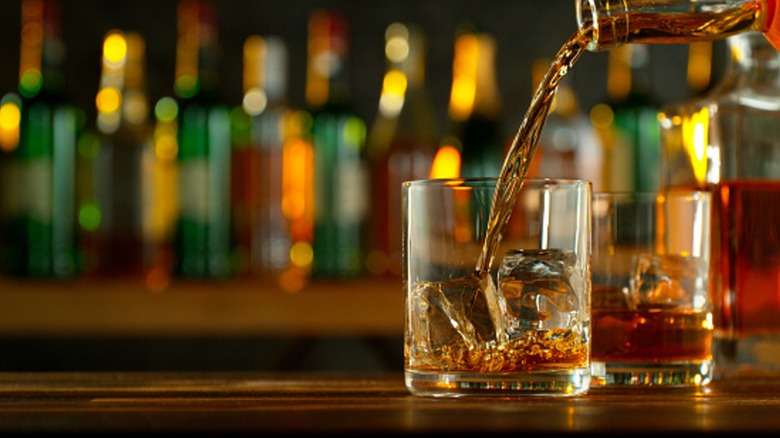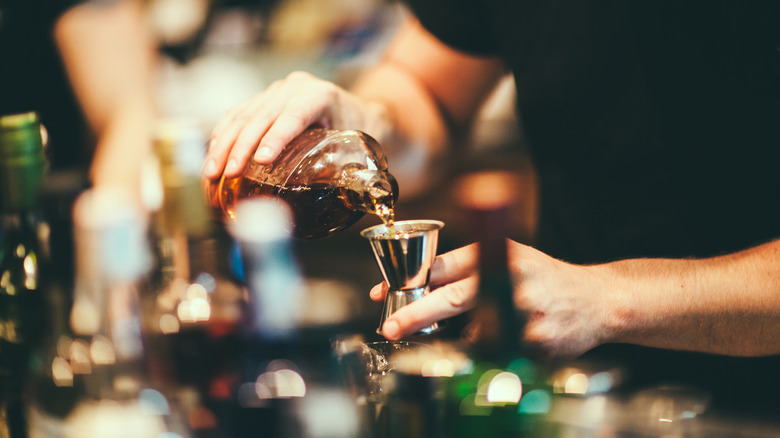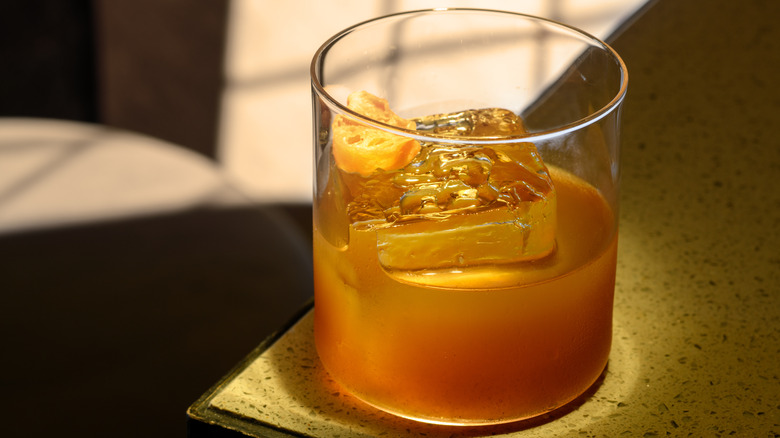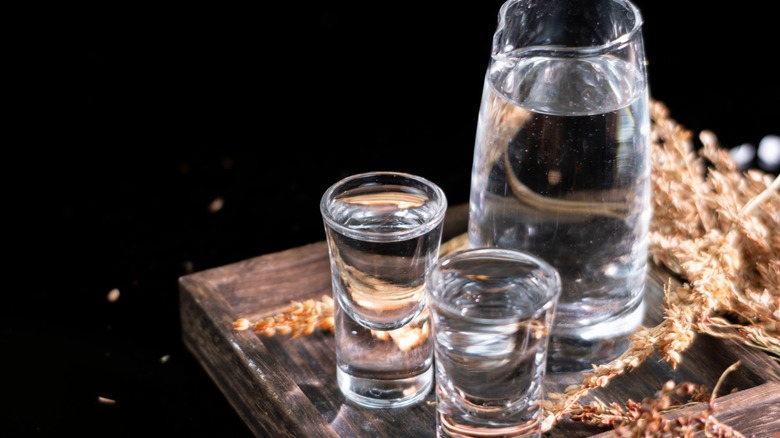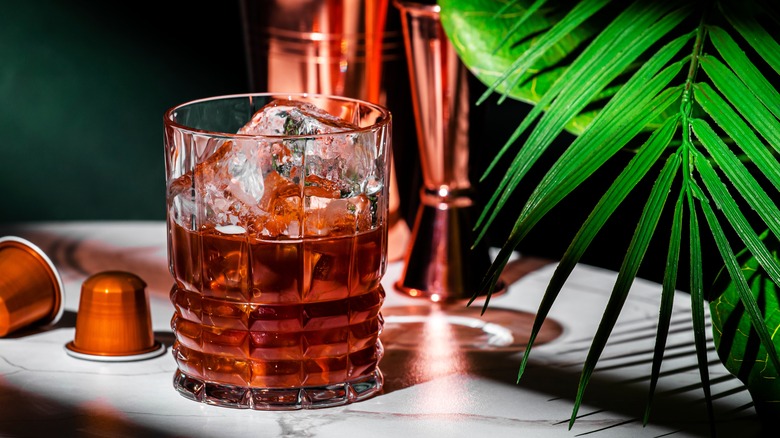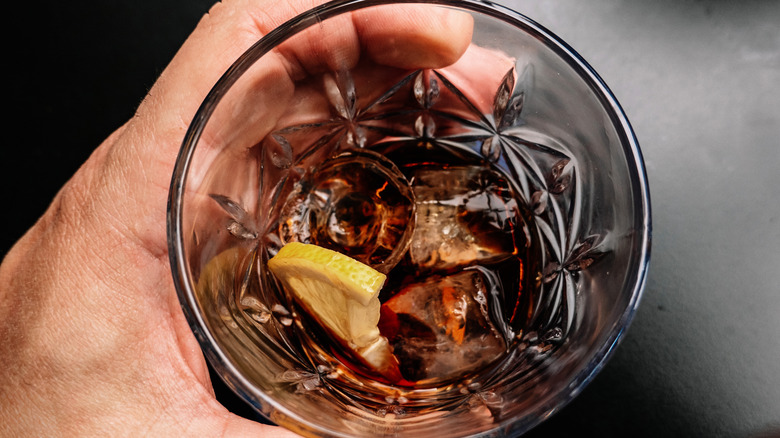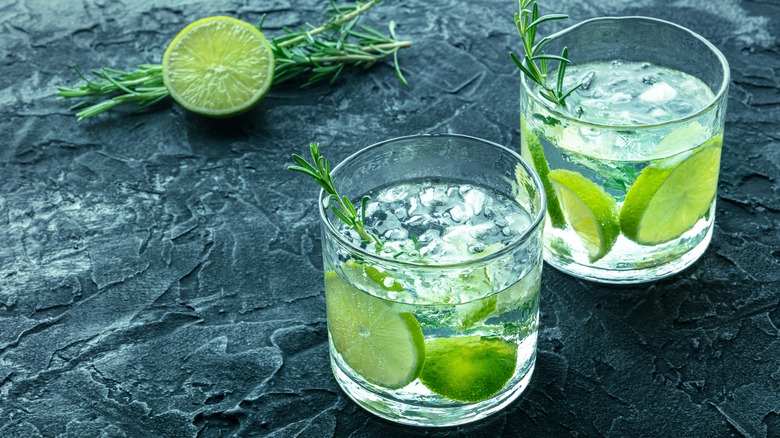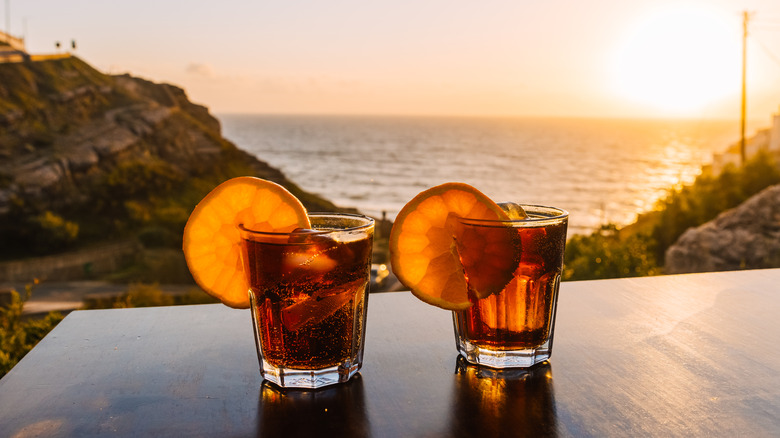Old-School Alcohol Nicknames Nobody Uses Anymore
Alcohol has lived a million lives throughout the annals of human existence, and with each age came a collection of colorful names that made liquor culture one of the most creative venues in the world of food and drink. The deeper you dig into the past, the more descriptive terminology you uncover, an entire lexicon that represents the thrilling love-hate relationship humanity has with one of its most renowned creations. Some of these playful monikers celebrate the myriad effects of alcohol, while others warn of liquor's destructive tendencies when knocking back a few turns into sloshing down one too many.
Having such a long and celebrated history means many old-school alcohol nicknames have fallen by the wayside, being forgotten about when the culture changed or replaced by hipper language by the contemporary cocktail crowd. There are archaic aliases alcohol has gone by through the centuries, long-vanished lingo that only makes appearances in historic films featuring cowboys, gangsters, or settlers.
From regional pet names derived from historic events to clever bon mots that drinkers around the world have used through the ages that have been relegated to the hootch (liquor) cabinet of yore. They may not be the trendy drink names they once were, but they're part of the story of alcohol as much as grain, water, and yeast.
Bootleg
It sounds like liquor piracy on the high seas, but the word "bootleg" became a well-known synonym for booze during Prohibition, when distillers worked illegally to create homemade brews for those brave enough to engage. But the word itself reaches further back into history, arising in the Old West to describe the practice of stashing a flask in one's boot to make illegal trades with Native American tribes. The verb form, "bootlegging," became a natural extension of the original term. It wasn't simple slang, either; early written references date back to 1889, made by the Attorney General and Probate Judge of Anderson County, Kansas, bringing the word into the legal world.
When Prohibition descended in the 1920s, bootleg liquor became an underground industry. Alcohol outlaw E.J. Moran, a homebrewer who hid his liquid gold in a pair of boots, called himself the first "real bootlegger" ever to be caught by authorities after his arrest.
Once liquor became legal, the term as it applied to liquor became archaic, though bootlegging has taken other forms through the decades. Anyone who's watched pirated DVDs, downloaded music from Napster, or listened to an unsanctioned recording of a concert have also engaged with bootleg materials. Whether people who still use the word know of its liquor-based origins is up for debate.
Nose Paint
No, not the kind a clown slathers on before bounding through the big top ... but close. One of the most noteworthy effects of overindulging in alcohol is a flushed appearance, particularly a ruddy nose. Hence, the term "nose paint" became a descriptive way to refer to the ruddy effects of booze-binging. Specifically, nose paint references whiskey, and "painting your nose" means taking a drink — not exactly liquor lingo you're likely to use with your drinking buddies while checking out the new cocktail bars in town.
Like everything, this quaint alcohol nickname has its time and place. In the late-1800s, "nosepaint" appeared to be a coded term for liquor that gave drinkers a colorful way to describe their drinking activities. Modern medical terminology for nose paint includes Alcohol Nose, described as enlargement and disfigurement of the nose due to excessive alcohol consumption. The bumps that arise as a result of this condition are sometimes referred to as "gin blossoms." So, even though nose paint may not be used by the contemporary drinking crowd, remnants of this playful linguistic antique linger on.
Antifogmatic
Such a scientific-sounding term for what amounts to a bit of booze, this "antifogmatic" is. It sounds more like a description for a highly-caffeinated drink that would clear the haze caused by booze, but the word arose from liquor's ability to drive away the chill of a damp fog. It may be one of the most apt stand-ins for the actual name of your favorite liquor, especially if you enjoy it as a warm-up on cold evenings. Think hot rum, warm cider, nogs, and grogs — wintry drinks that serve the dual purpose of soothing both body and soul. Of course, raw liquor like scotch or vodka are equally capable of stoking an inner fire and are just as antifogmatic (the adjective form!) as their mixed counterparts.
The term developed over time, first garnering written mentions in the late-1700s — sometimes referring to the half-pint of whiskey taken in the morning as a medicinal balm to "clear the fog" of sleep. It was a useful word that bestowed an air of legitimacy to the idea that drinking liquor could have a curative or preventative effect. Similar terms used to this end were found in the travel logs of John Lambert and include "gum-tickler," which was rum taken while fasting, and "phlegm-cutter," which was a double-up of the liquor of choice. Lambert specifically references Virginia and its practice of "dram-drinking" as a prescription rather than an indulgence.
Bug Juice
According to some sources, "bug juice" is an archaic Army reference to alcohol. In the earliest days of America, the Continental Army, soldiers were rationed a gill (about two ounces) of either rum, brandy, or whiskey per day. By the time the Civil War was in motion, "bug juice" was a part of soldier vernacular, appearing in military songs warning enlisted men to temper their consumption or face expulsion from the armed forces.
Over time, "bug juice" came to represent poor quality liquor — whiskey in particular. In military terms, the name made the leap from moonshine for Colonial warfighters to a sugary Kool-Aid beverage served on Navy ships, alongside the usual coffee and water. In this instance, the tale told is that packages of powder used to make the drink contained pictures of Bugs Bunny, which gave rose to the name. That seems a long way from the alcohol origins, but the possibility exists that this old-fashioned name for liquor shapeshifted as it passed through successive generations.
Google the term now and you'll find that bug juice refers to a lunchbox punch drink (non-alcoholic, of course), an insect repellant, and a T.V. series about summer camp. Maybe it's time for someone to pick it back up when talking about cheap liquor to see if it goes viral. Stranger things have happened.
Ol' Red Eye
It's no mystery how the term "ol' red eye" arose as a liquor-friendly nickname; drink enough of the stuff, and you'll wake up the next morning with bleary vision and a network of red veins crisscrossing the whites of your eyes. It's a specific nod to the cheaper, stronger version that hits you hard and knocks you crooked. The earliest written reference dates to 1819 and was used side-by-side with "rot gut," which gives some idea of the caliber of liquor ol' red eye presented to the drinkers of the time.
The term still makes appearances in the 21st century, as tributes to the liquor and lingo of long ago, but it may be a whiskey falsehood to think of "ol' red eye" as referring only to cheap whiskey. Boot Hill Distillery bottles Red Eye Whiskey, an homage to frontier distillers who sped up the aging process to create the "red eye" spirits. And American Cowboy Whiskey offers a more direct explanation of how real "red eye" comes about: thanks to proper aging, a better bourbon whiskey will acquire a reddish tint. So, depending on who you ask, "ol' red eye" is either a high-grade elixir or a low-grade intoxicant ... which all rolls up under the whiskey heading regardless.
John Barleycorn
This may be one of the most archaic names used in America to describe liquor, with a folkloric origin that speaks of the nation's flip-flopping attitudes toward its creation and consumption. The name "John Barleycorn" sounds like a legendary frontier character akin to Johnny Appleseed or Paul Bunyan. But the origin of this figure isn't heroic in nature; it's more of a story about how the opposing forces of whiskey making and the temperance movement that pitted drinkers against abstainers.
The name has been around for centuries as part of English folklore, most famously captured by Scottish poet Robert Burns. In the poem, John Barleycorn is painted as a Christ-like figure beset by "three kings from the East," a metaphor for English royalty whose efforts to stop farmers from growing the crops used by distillers were thwarted by a new crop the next season. The description of this sturdy character follows the plant's growth cycle, reinvented as the life of a hero who rises in spring, thrives in summer.
By autumn, John Barleycorn has weakened enough to be overtaken by his enemies, who mow him down and subject him to terrible tortures — a vividly descriptive imagining of the fermentation process. Burns extols the virtues of John Barleycorn's demise in the lines, "For if you do but taste his blood, 'Twill make your courage rise," Burns writes, a reference to whiskey's power to embolden those who indulge.
Tipple
"Tipple" may be one of the most fun old-fashioned names for alcohol ever coined; it sounds more like a sugary drink or some sort of penny candy sold by dudes in striped vests and straw hats. But it actually reaches much further back in the barkeep's history, first arising in 1560 as a twist on "tipler," meaning "pub keeper" or "alcohol seller." It's also related to "tipper," which can mean both drinking a little and drinking a lot and giving rise to a fun, buzzy confusion for anyone who uses it. Imagine telling your boss you're headed for a "tipple" after work and not clarifying whether you're just having a drink or closing down the bar.
If you're seeing a connection between this old-fashioned liquor nickname and the word "tipsy," you're thinking in the right direction. This description for having had a few too many coincides with the use of "tipple" and "tipler" in the liquor lexicon. Yet another term, "tip," came to mean "one who drinks too much," likely giving rise to the idea of "tipping back a few" being an undesirable habit.
Try tossing "tipple" into the conversation at your next happy hour or cocktail party and see how many of your fellow partygoers are hip to your boozy jive. And don't forget to "tip" your server on the way out.
Hooch
The word "hooch" caught on and never really let go, even though it definitely sounds dated nowadays. It's also become a catch-all for alcohol in general, though it originally referred to booze of a lesser quality — cheap whiskey in particular. It may seem like a nonsensical syllable that tumbled out of the mouth of someone who'd had a little too much to drink, but its roots have genuine historical significance.
The origins of this old-fashioned alcohol name can be traced directly to a Tlingit tribe in Alaska, who created a liquor called "hoochinoo." The tribe's name was Hutsnuwu; "hoochinoo" was a pronunciation, and "hooch" was the shortened version. The liquor became such a common substance in Alaska, it inspired a report that pinned the majority of issues in the region on "hooch."
These days, if you hear "hooch" floating around your cocktail crew, you can bet someone has either been experimenting with home distilling or tinkering with strong cocktail recipes. Either way, if you're tempted to "hit the hooch," you might want to verify the ABV before taking your first sip.
Moonshine
One of the most storied monikers for making homemade liquor, "moonshine" has maintained a hold on beverage culture, attaining a sort of rustic romance through the decades. You may know it by its other nicknames, "corn whiskey" and "white lightnin'." All three names refer to booze made illegally and usually using corn as a base and yeast and sugar as fermenting agents. In fact, both the sweet odor given off by the sugar during distillation and the large purchases of sugar made by moonshiners were giveaways to agents on the hunt for criminal stills back in the moonshine age.
Moonshine-making is part of the fabric of Appalachian America, largely as a backlash to high taxes on Scottish and Irish whisky makers who emigrated to the States in the 18th century. With such contentious legislation resulting in taxes almost 8 times as much as the distiller's cost and the gradual increase of liquor traffic through states like Oklahoma, the modern Prohibition movement began to take hold and the practice of making moonshine (a reference to the secret nighttime activities of illegal distillers) arose.
Making the situation even more thrilling, moonshine is a homemade version of whisky — and whisky is a Gaelic word that translates to "water of life." So, in an upside-down, roundabout way, moonshine makers were conjuring the water of life, though anyone who's ever had a straight shot of this powerful liquor may beg to differ.
Firewater
Native American tribes had their own terminology for alcohol, the most familiar of which is undoubtedly the word "firewater," though its origins may not be what most people presume. Recognizing that tribesfolk were more likely to engage in fur trading when plied with a little liquor, Hudson Bay Trading Company began shipping its England-based whiskey to America. Rather than directly moving the distillery kegs from country to country, the booze was separated in smaller casks to make shipping easier.
The canny — and some would say devious — traders began noticing that if they diluted the whiskey, the liquor would go further, thus leading to even more furs traded. It was a sneaky move that may have worked initially, but Hudson Bay Trading Company couldn't pull off the ploy forever. Tribes became wise to the fact that they were receiving a thinned-down version of the original whiskey and began testing the strength by pouring it over an open flame. The more the fire flared up, the stronger the composition — hence the term "firewater," a reference to the higher-proof whiskey.
Nowadays, you'll find Fire Water Cinnamon Liquor burning up shelves, Firewater Baijiu bottled up and ready to pour, and Firewater Distillery offering agave spirits. Whether the origins of the term are factored into the distilling process for any of them is a mystery all its own.
Dutch courage
In modern parlance, liquor is referred to as "liquid courage" for its ability to strip away a drinker's inhibitions for better or worse. The etymological ancestor of this is "Dutch courage," which came about as a reference to the need of ruffians to knock a few back before putting up their dukes for a rowdy fight. It was a disparaging term and an ethnic slur used by the British to degrade their rivals in the Netherlands, a slur that suggested the Dutch required an infusion of bravery before heading into battle. That's a far cry from its current use to describe gearing up to chat with your crush or grabbing the mic for your turn at karaoke night.
The implication of "Dutch courage" and its derivatives is unmistakable: The more you drink, the braver you become — or so the assumption goes. Originally, the drink in question was likely gin, which was cheap and readily available in 18th-century England. It also happened to be invented by Franz de le Boë, a Dutch physician, tightening the connections between this liquor-leaning term and its geographical reference.
Though it's evolved through the years, "Dutch courage" still exerts its influence on cocktail culture. If you're in Baltimore, you can drop into Dutch Courage, a gin-centered cocktail bar that celebrates the roots of the term and its potentially associated spirit. To prevent any potential insults to the Dutch, maybe stick with "liquid courage" when telling your crew you need to let loose a little.
Budge
A somewhat confusing term that seems to slyly wink and nod at what's waiting in your glass, the word "budge" can be found as a nickname for liquor in texts dating back to 1821. It's also one of the lesser-known terms, one that requires a bit of historical hopscotch and maybe a bit of reaching to determine its evolution. But part of the fun of digging around in the etymological sandbox is sleuthing about to see what connections can be made. This counts double when the subject is the rich world of liquor language.
In Scotland, a "budge kain" is a pub, a hint at how "budge" may have become a stand-in for "alcohol." But it translates to "public house" rather of anything directly related to booze or drinking. Step back a little further in time, and you can find references to the Middle English word "bouse," meaning "to drink," from around 1300. Of course, this is the great-great-great-grandpa of the word "booze," a liquor moniker still used today.
If you make the leap and take a peek at Wiktionary, you can find two alternate forms of the word "budge," one of which is "bouge." Is it possible that the dots connect between "budge," "bouge," and "bouse" — all with similar spellings and meanings but slightly different pronunciations? It's a tasty possibility to think about while sipping on your favorite budge — er, bouge — make that booze. They all mean the same thing anyway (maybe).

